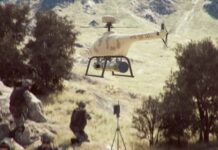Following over 2,000 lab and field tests the Autonomous Navigation System (ANS) under development at General Dynamics Robotic Systems for the U.S. Army has passed the Critical Design Review milestone in March 2010 and is moving to prototype fabrication phase, toward integration and initial testing on a prototype Armed Robotic Vehicle (ARV) in 2011. The Army’s future robotic platforms and the seven Manned Ground Vehicles (MGV), as part of the Future Combat Systems (FCS) program, the $237 ANS program has sofar survived the termination of the FCS and is fully funded through 2013.
Originally destined for integration into the Army’s future robotic platforms and the seven Manned Ground Vehicles (MGV), as part of the Future Combat Systems (FCS) program, the $237 ANS program has sofar survived the termination of the FCS and is fully funded through 2013. This capability could introduce ‘transformational’ capabilities with future combat vehicles, empowering conventional vehicles or future, robotic platforms with unmanned, and autonomous operating modes. The ANS CDR is among the first in a series of critical Increment 2 reviews underway for the Army’s Brigade Combat Team (BCT) Modernization program.
The ANS system integrates a suite of sensors processors and actuators enabling automotive platforms to conduct autonomous navigation, perform area perception, path-planning and vehicle-following functions operating as unmanned ground vehicles, or optionally manned vehicles, allowing vehicles to move on the battlefield with minimal human oversight. Among the tasks the system already performed in tests are ‘move-on-route’, ‘obstacle detection and avoidance’ and ‘leader/follower’ capabilities in both day and night conditions.
Mr. Larry Hennebeck, Assistant Product Manager ANS explained the suite’s sensors comprise three types – video, Laser Radar (LADAR) and milimeter-wave sensors. The video cameras provide the eyes of the systems, with multiple cameras covering a wide field with three-dimensional stereo-vision, viewing fore and aft. LADARs are also pointed fore and aft, creating a 3D image of the secene while the milimeter-wave sensors indicating distance and closing speed to obstacles. Sensor feeds are processed through a ‘super computer on a board’. Five such boards are crunching the data at a ‘terraflop’ rate, fusing all ‘senses’ into a situational picture providing the system a perception of the scene, enabling the machine to plot the optimal route along the preplanned waypoints, where the least obstacles are encountered, while conforming to the directions and commands set by the user, guiding the vehicle’s next action and proceeds. The system has already been tested on vehicles including Strykers, the MULE Engeneering Evaluation Units, and Light Medium Tactical Vehicles (LMTV). Once matured, ANS system are expected to cost around $300,000 and be integrated into many combat and combat support vehicles, enabling driverless operations of manned or unmanned vehicles.
















